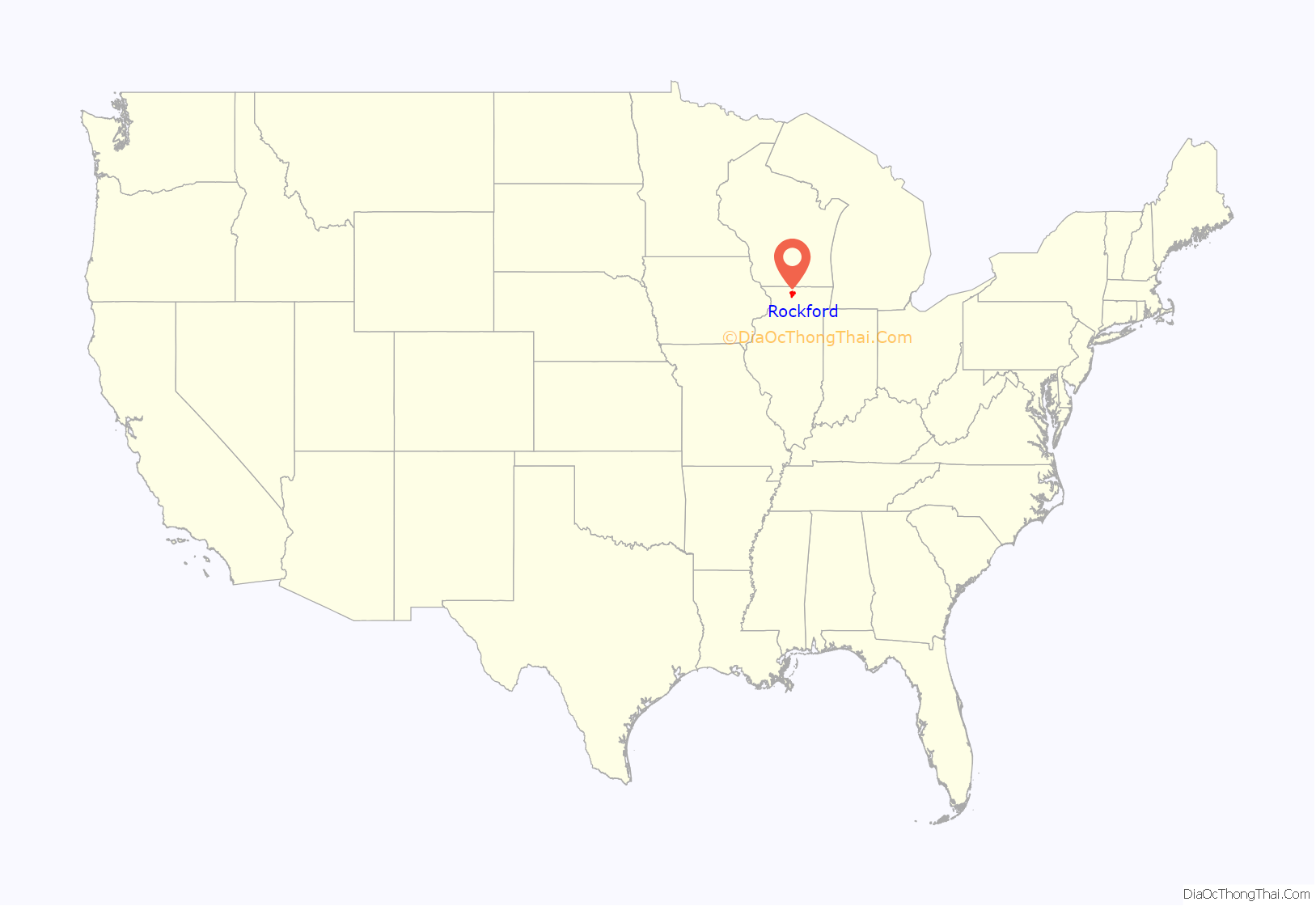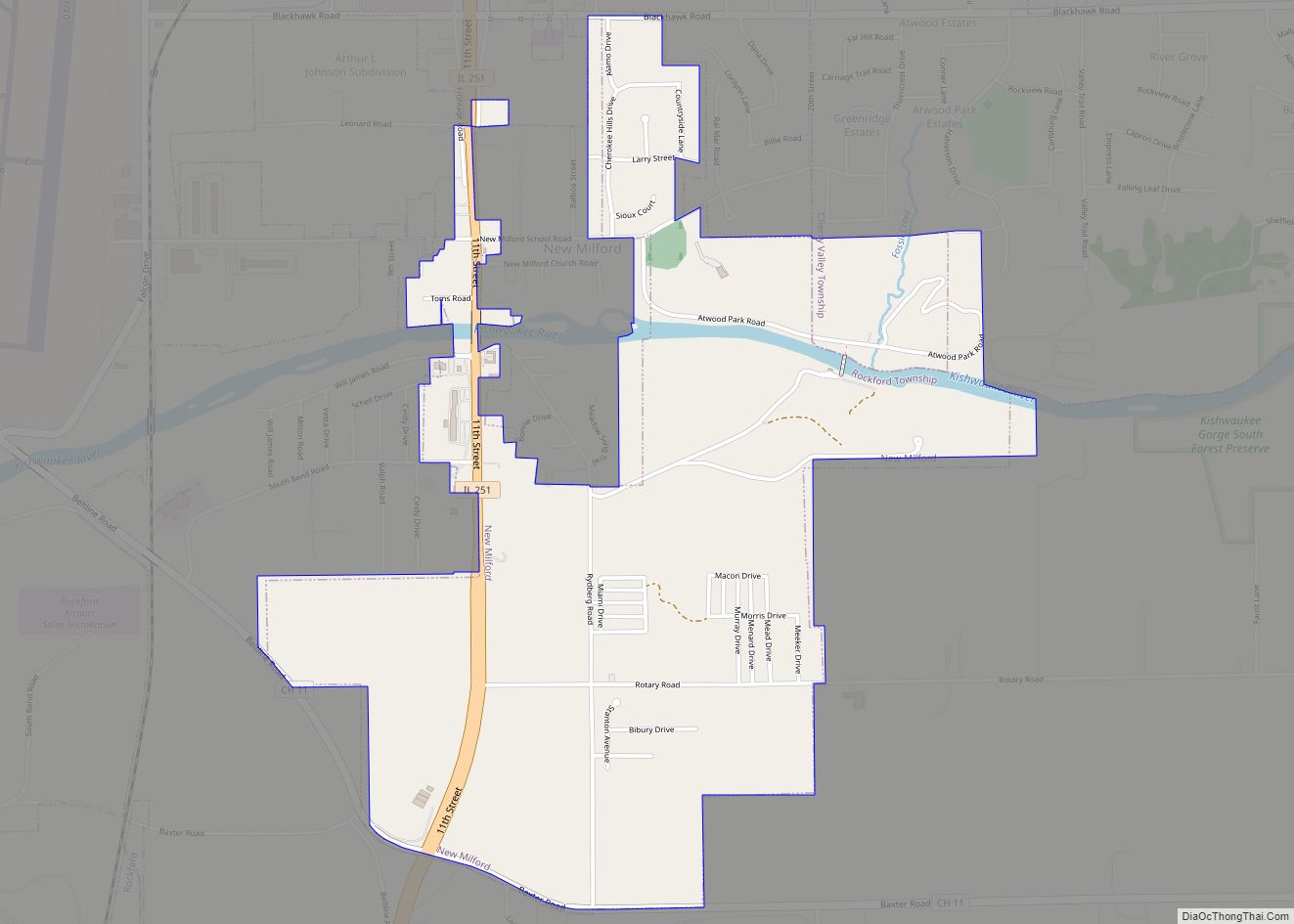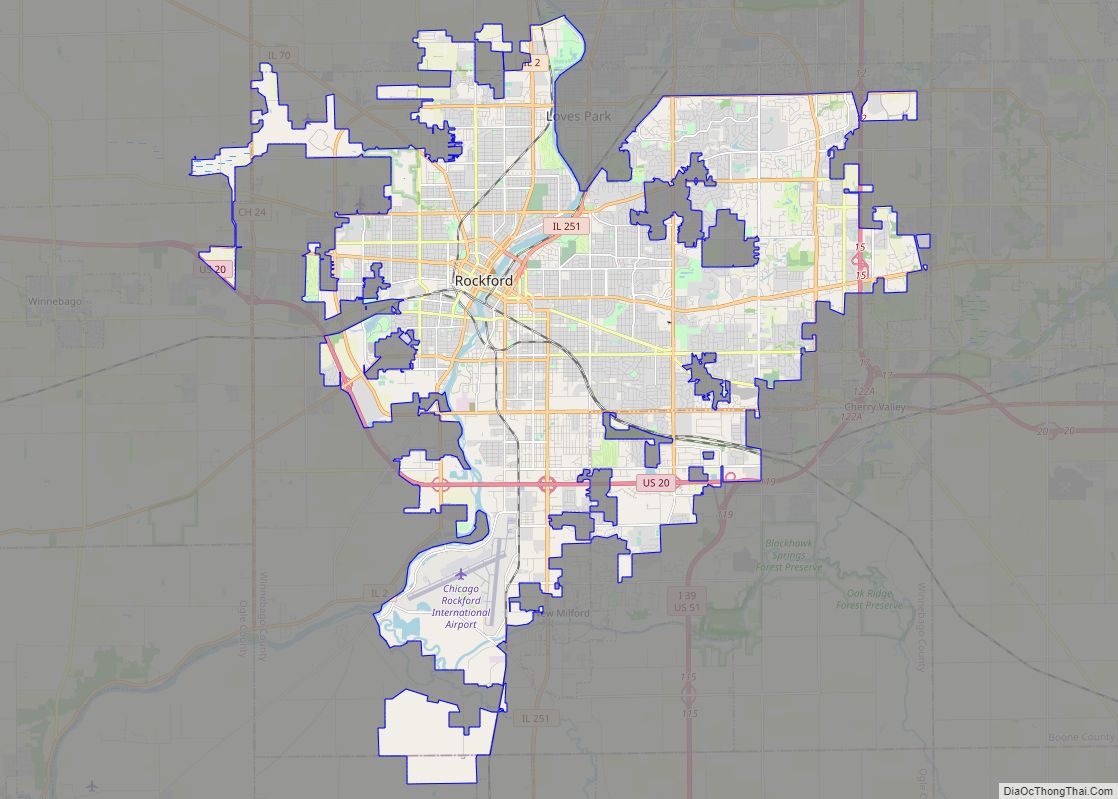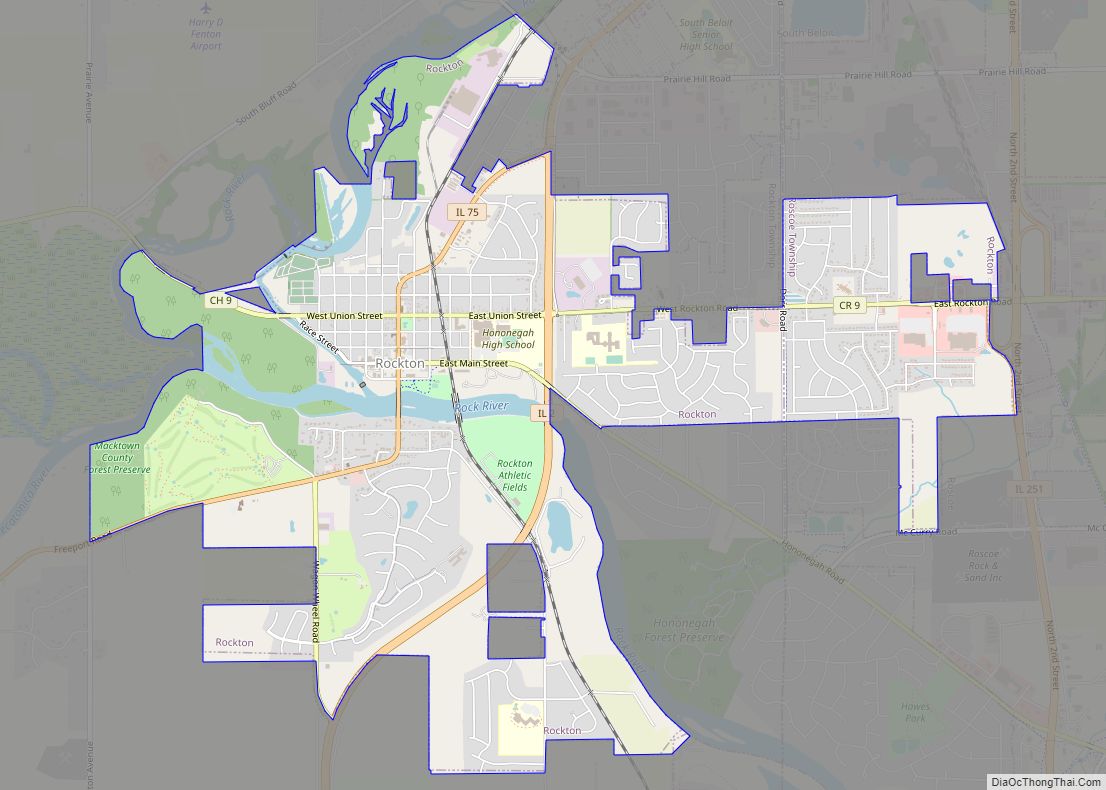Rockford is a city in Winnebago County, Illinois, United States. Located in the far northern part of the state on the banks of the Rock River, Rockford is the county seat of Winnebago County (a small portion of the city is located in Ogle County). The largest city in Illinois outside of the Chicago metropolitan area, Rockford is the fifth-largest city in the state and the 171st most populous in the United States. In the 2020 census, Rockford had a population of 148,655 anchoring the Greater Rockford Metropolitan Area with a population of 348,360.
Settled in the mid-1830s, the position of the city on the Rock River made its location strategic for industrial development. In the second half of the 19th century, Rockford was notable for its output of heavy machinery, hardware and tools; by the twentieth century, it was the second leading center of furniture manufacturing in the nation, and 94th largest city. During the second half of the 20th century, Rockford struggled alongside many Rust Belt cities. Since the late 1990s, efforts in economic diversification have led to growth of automotive, aerospace, and healthcare industries, as well as the undertaking of various tourism and downtown revitalization efforts.
Nicknamed the Forest City, Rockford is presently known for various venues of cultural or historical significance, including Anderson Japanese Gardens, Klehm Arboretum, Rockford Art Museum, Tinker Swiss Cottage, the BMO Harris Bank Center, the Coronado Theatre, the Laurent House, and the Burpee Museum of Natural History. Its contributions to music are noted in the Mendelssohn Club, the oldest music club in the nation, and performers such as Phantom Regiment and Cheap Trick. Notable outdoor or recreational spots near Rockford are Rock Cut State Park, Atwood Homestead County Forest Preserve, and Lowden State Park.
| Name: | Rockford city |
|---|---|
| LSAD Code: | 25 |
| LSAD Description: | city (suffix) |
| State: | Illinois |
| County: | Winnebago County |
| Incorporated: | 1839 (as a town) January 3, 1852 (as a city) |
| Elevation: | 728 ft (222 m) |
| Land Area: | 64.91 sq mi (168.11 km²) |
| Water Area: | 1.01 sq mi (2.63 km²) |
| Population Density: | 2,290.24/sq mi (884.27/km²) |
| FIPS code: | 1765000 |
| Website: | rockfordil.gov |
Online Interactive Map
Click on ![]() to view map in "full screen" mode.
to view map in "full screen" mode.
Rockford location map. Where is Rockford city?
History
Settlement and development
Rockford traces its roots to 1834, as the combined settlements of Midway were founded on both banks of the Rock River. On the west bank, Germanicus Kent and Thatcher Blake (with his slave Lewis Lemon) founded Kentville; the east bank was settled by Daniel Shaw Haight. With the location of the Rock River equidistant between Lake Michigan and the Mississippi River, the combined settlement derived the name “Midway”. In 1836, Winnebago County was created (from both Jo Daviess and LaSalle counties), with Midway named as its county seat, as it was “halfway between Galena and Chicago on a line of four-horse coaches.”
In 1837, the village of Midway was renamed Rockford, highlighting a rocky river ford across the Rock River in the village. The same year, Rockford established its first post office (with Daniel Shaw Haight as the first postmaster). In 1840, the first weekly newspaper began circulation. In 1847, Rockford Female Seminary (today Rockford University) was founded. On January 3, 1852, Rockford was officially chartered as a city; a year later, the long-running “Forest City” nickname first appeared, used by the New York Tribune. Also in 1852, the Galena and Chicago Union Railroad connected Rockford to Chicago by railroad.
At the time of its founding, many of the village’s residents were transplants from the Northeastern United States and upstate New York. Descended from English Puritans, the Midway/Rockford population was similar to much of the rest of northern Illinois and nearly all of Wisconsin during the mid-19th century. After the Black Hawk War, additional immigrants moved to northern Illinois; during the 1830s and 1840s, Rockford and Winnebago County were considered a cultural extension of New England.
During the antebellum period, Rockford shared abolitionist leanings, lending considerable support to the Free Soil Party and the later Republican Party. In 1848, 42 percent of voters in Winnebago County (where Rockford dominated as the county seat) voted for Martin Van Buren. In 1852, Free Soil candidate John P. Hale became the first presidential candidate to visit Rockford, although he would only receive 28 percent of the vote. In 1860, Abraham Lincoln won 3,985 votes in Winnebago County to the 817 votes of Stephen A. Douglas.
The 1850s brought industry that would change Rockford forever. In 1853, inventor John Henry Manny moved to Rockford to produce horse-drawn mechanical reapers for farmers and transport the finished products by rail. Chicago implement manufacturer Cyrus McCormick (whose company became International Harvester) took Manny to court after he produced nearly 6,000 machines; Manny would prevail on both judgement and an appeal. Along with the production of agricultural machines, Swedish furniture cooperatives established the city as a manufacturing base. The Rockford Union Furniture Company, under John Erlander, spearheaded these cooperatives. Today, Erlander’s home is a Rockford museum that shows his efforts in elevating Rockford to second in furniture manufacturing in the nation, behind Grand Rapids.
During the Civil War, one of the first Illinois regiments to be mobilized, the Zouaves, were from Rockford. The city also served as the site for Camp Fuller, a training site for four other infantry regiments.
In 1884, Rockford established its first city-wide public school district, constructing Rockford Central High School in 1885; following the construction of the high school, the district began construction of brick multi-story multigrade school buildings across the city.
The Rockford Female Seminary became the alma mater of Jane Addams in 1881. This move accompanied the Seminary’s transition into a more complete curriculum, which was represented by its renaming to Rockford College in 1892. Culture flourished with the founding of the Mendelssohn Club in 1884, which became the oldest operating music club in the United States. This was complemented by the construction of a Carnegie library in 1902, which became the first building of Rockford’s public library system. 1903 saw the dedication of the Winnebago County Veterans Memorial Hall in the presence of sitting President Theodore Roosevelt. Roosevelt returned to Rockford during his campaign in 1912 and again to address the soldiers at Camp Grant, a training site for World War I soldiers.
Twentieth century
The twentieth century saw demographic changes to Rockford. An influx of Italians, Poles, Lithuanians, and African Americans replaced the previously dominant Irish and Swedes. The city was also no stranger to contemporary political issues. Electorally divided between wets and drys on the subject of prohibition, Rockford featured a coalition of labor unionists and socialists that elected numerous aldermen and carried 25 to 40 percent in mayoral elections. During World War I, an antiwar protest by the Industrial Workers of the World led to 118 arrests. In 1920, the city was a target of the Palmer Raids. While its congressional district favored Republicans, Rockford continuously elected former Socialists as mayor between 1921 and 1955.
One of its contemporary attractions, the Coronado Theatre, opened in 1927. Noted for its atmospheric styling, the Coronado rivaled its counterparts in Chicago and was added to the National Register of Historic Places in 1979. Camp Grant was turned over to the Illinois National Guard. During World War II, it reopened as an induction center and POW detention camp. The USS Rockford, a Tacoma-class frigate named for the city, was commissioned in March 1944 and earned two service stars.
In the September 1949 issue of Life magazine, postwar Rockford was described as “nearly typical of the U.S. as any city can be.” Due to this archetypal nature, sociologists like W. Lloyd Warner warned of the necessity to “understand the realities of their system.” In the late 1950s, Rockford lost over 50,000 trees to Dutch elm disease, thinning the tree canopy of the “Forest City” for decades.
From 1955 to 1965, several events would take place that would shape the development of Rockford into the 21st century. In 1956, construction was approved for a four-lane U.S 20 bypass; along with shifting truck traffic away from the downtown routing of the highway, the bypass established much of the southern border of the city (which remains to this day). In 1958, Interstate 90 was completed in Illinois, becoming the Northwest Tollway; in a decision that would change Rockford forever, the interstate highway was not routed through the city, but near the Winnebago-Boone county line, with the eastern terminus of the US 20 bypass in Cherry Valley.
In 1963, the Rockford area was selected by Chrysler Corporation to construct an assembly plant; the final site of what is now the Belvidere Assembly Plant is southwest of Belvidere, between US 20 and Interstate 90. While not located directly in the city, the Chrysler assembly plant has served as one of the largest employers of the region since its 1965 opening.
The growth of Rockford led to many changes to its educational systems. In 1955, Rockford College (now Rockford University) became co-educational for the first time. Coinciding with the expansion of the student body, the college outgrew its near-east side campus in use since the 1840s. Following the acquisition of land in 1957, construction began on its present-day campus location, opening in 1964. In 1964, Rock Valley College was founded as a two-year community college, with construction on its campus commencing in 1965.
Prior to the 1960s, neighborhood and economic growth in Rockford largely mirrored itself on both sides of the Rock River. As the 20th century progressed, growth in western Rockford (and established neighborhoods in eastern areas of the city) struggled to compete with economic development that moved further east. From the late 1950s, downtown Rockford (centered around the intersection of IL 2 and US 20; Main Street and West State Street) began to decline as the primary shopping district of the city. In 1956, North Towne Mall opened on the far northwest side of the city, with Colonial Village opening on the (then) far east side in 1962, both of which were partially enclosed (some stores had exterior entrances). In 1973, Cherryvale Mall was opened as the first fully enclosed shopping mall in the city; nearly 6 miles from the city center, the mall was located at the intersection of the US-20 bypass and the Northwest Tollway, sharing a city border with Cherry Valley.
While growth at the eastern end of Rockford undersaw favorable conditions for growth, established neighborhoods began to suffer irrevocable decline. In the 1970s, efforts commenced to revitalize downtown Rockford, once the primary shopping district. In a highly criticized decision, the city reconfigured several blocks of downtown into a pedestrian mall, closing off the Main Street/West State Street intersection to traffic. In 1975, what the local press characterized as one of the most well-known and haunting crimes took place when newspaper delivery boy Joey Didier was kidnapped and murdered by Robert Lower. In the late 1970s, Symbol, a 47-foot tall Alexander Liberman abstract sculpture was placed in the center of the pedestrian mall. In 1980, then Congressman John B. Anderson, representing the 16th Congressional District in Illinois which includes Rockford, ran for President of the United States. To further attract commercial growth, the MetroCentre 10,000-seat multi-purpose arena, was opened in 1981.
Rockford would be hit hard by the early 1980s recession, becoming one of the highest-unemployed cities in the United States. In 1981, rail service to the city ended as Amtrak ended the Dubuque-to-Chicago Black Hawk route. After struggling to compete with more modern facilities, the Coronado Theatre showed its last movie in 1984, shifting solely to stage performances. To expand passenger service, the Greater Rockford Airport rebuilt its passenger terminal in 1987, although the access of Rockford to the Northwest Tollway (to the much larger O’Hare Airport) became a popular alternative.
In a decision that continues to affect Rockford to the present day, in 1989, Rockford Public School District 205 closed several schools across the city in a cost-cutting decision. In the aftermath of the decision, the school district was found guilty in federal court of discrimination against minority students. From 1993 to 2001, the school district was under federal oversight to desegregate its schools, costing over $250 million.
Twenty-first century
With its economy predominately based on manufacturing, the city has been affected by the deindustrialization of the Rust Belt. There has been an emphasis on services, especially medicine and education.
During the 2000s, a movement began to reverse urban blight of downtown Rockford, which had begun in the 1960s. Following an 18-month multi-million dollar renovation and expansion, the Coronado Theatre was reopened in 2001. In 2008, the MetroCentre downtown arena completed a $20 million renovation (renamed the BMO Harris Bank Center in 2011). In 2009, the downtown pedestrian mall was removed as part of a street refurbishment project, restoring Main Street (Illinois Route 2) to two-lane traffic for the first time in nearly 45 years.
Prior to the onset of the Great Recession, housing in Rockford was affected by catastrophic weather events. In 2006 and 2007, Keith Creek underwent 100-year flooding events, damaging hundreds of older homes on the near east side of the city. In response, the city secured FEMA grants, demolishing over 100 homes; to reduce the severity of future flooding events, the creek is being reconstructed (through 2019) and left as greenspace. As an effect of the recession, by 2013, thirty-two percent of mortgages in the city were upside-down. While remaining the largest city in Illinois outside Chicago and its suburbs, estimated population decline from 2010 to 2017 led Rockford to be overtaken by Joliet and Naperville (the latter, slightly), effectively making it the fifth-largest city in Illinois.
From 2014 to 2018, the unemployment rate in Rockford has fallen from 12.9 percent to 4.4 percent (the lowest since 2000). While predominately a manufacturing community since World War II, Rockford has struggled to diversify its industrial base. Shifting from agricultural machinery and furniture, manufacturing in the city remains dominated by fasteners, automotive suppliers (representing FCA Belvidere Assembly), and the aerospace industry (Woodward and Collins Aerospace; the latter, tracing its roots to Sundstrand Corporation). In 2012, Woodward selected suburban Loves Park for a $200 million manufacturing campus toward its energy control and optimization systems. Boeing included Rockford in a list of five finalists to manufacture the 777X during union disputes in 2014. In 2016, AAR Corporation opened a MRO facility at the Rockford airport with a hangar large enough to fit a Boeing 747-8.
During the 2010s, all three major health care providers in Rockford underwent major expansions of their facilities. SwedishAmerican, in partnership with the University of Wisconsin Carbone Cancer Center, opened a $39 million Regional Cancer Center in 2013. In 2014, MercyHealth (based in Janesville, Wisconsin) acquired Rockford Health System, the operator of Rockford Memorial Hospital. In 2019, MercyHealth opened Javon Bea Hospital-Riverside (named after the MercyHealth CEO and its Riverside Boulevard/Interstate 90 location); its second hospital in Rockford, the $505 million complex was the largest construction project in the history of the city.
Rockford Road Map
Rockford city Satellite Map
Geography
According to the 2010 census, Rockford has an area of 61.949 square miles (160.45 km), of which 61.08 square miles (158.20 km) (or 98.6%) is land and 0.869 square miles (2.25 km) (or 1.4%) is water. Neighboring communities that border Rockford, and are considered an integral part of the Rockford metro area, are the cities of Loves Park, Machesney Park, Belvidere, and the villages of Winnebago, Roscoe, Rockton, Poplar Grove, New Milford, and Cherry Valley.
Also of note, South Beloit, Illinois and Beloit, Wisconsin are part of this continuous urban area that stretches for approximately 30 miles along the Rock River from the Chicago Rockford International Airport north to the Southern Wisconsin Regional Airport. Rockford is approximately 85 miles west-northwest of downtown Chicago, and 70 miles south-southeast of Madison.
Waterways
The Rock River forms the traditional center of Rockford and is its most recognizable natural feature. One of its largest tributaries, the Kishwaukee River, joins the Rock River at the southern end of the city near the Rockford airport. Since the 1946 closure of Camp Grant, much of the length of Kishwaukee has been redeveloped into parkland and forest preserves, effectively forming the southern border of the city. Other waterways that feed into the Rock River include Spring Creek (northeast region), Keith Creek (east region), and Kent Creek (west region). Of the 8 Illinois dams of the Rock River, the Fordham dam is located south of downtown.
Climate
Due to its location in the Midwest, naturally a deciduous forest, Rockford’s climate has four clearly defined seasons. Summers are usually hot and humid with the average high temperature in July (the hottest month) being 83.9 °F (28.8 °C). The winter months can bring bitterly cold Arctic air masses. The average high temperature in January (the coldest month) is 29.1 °F (−1.6 °C). June is Rockford’s wettest month while January is the driest. During a typical year, Rockford receives 37.24 in (946 mm) of precipitation.
Rockford and surrounding areas are prone to violent thunderstorms during March, April, May, and June. On April 21, 1967, a violent F4 tornado struck the neighboring town of Belvidere, killing twenty-four people and injuring hundreds more at Belvidere’s High School. Other severe weather events, such as hail and strong winds are common in these storms. On July 5, 2003 at 04:13, a line of severe storms and their associated high winds caused widespread damage on both the east and west sides of Rockford. Approximately 70,000 people were without power, with many on the west side suffering in the heat without electricity for a week. It took months to clear the damage, but because the storm struck so early in the morning there were no injuries or fatalities. However, these sometimes violent storms bring the majority of summer rainfall.
The city is also prone to severe snowstorms in winter, and blizzards are frequent winter occurrences. On January 13, 1979 over 9 inches (23 cm) of snow fell on Rockford in just a few hours during one of the strongest blizzards in the city’s history. The city averages approximately 36 inches (91.4 cm) of snowfall in a normal winter, but greater amounts are common. The snowiest winter in the history of the city was the winter of 1978–1979, when 74.5 inches (189 cm) of snow fell.
The record high temperature is 112 °F (44 °C), set on July 14, 1936 during the Dust Bowl, and the record low temperature is −31 °F (−35 °C), set on January 31, 2019.
See also
Map of Illinois State and its subdivision:- Adams
- Alexander
- Bond
- Boone
- Brown
- Bureau
- Calhoun
- Carroll
- Cass
- Champaign
- Christian
- Clark
- Clay
- Clinton
- Coles
- Cook
- Crawford
- Cumberland
- De Kalb
- De Witt
- Douglas
- Dupage
- Edgar
- Edwards
- Effingham
- Fayette
- Ford
- Franklin
- Fulton
- Gallatin
- Greene
- Grundy
- Hamilton
- Hancock
- Hardin
- Henderson
- Henry
- Iroquois
- Jackson
- Jasper
- Jefferson
- Jersey
- Jo Daviess
- Johnson
- Kane
- Kankakee
- Kendall
- Knox
- La Salle
- Lake
- Lake Michigan
- Lawrence
- Lee
- Livingston
- Logan
- Macon
- Macoupin
- Madison
- Marion
- Marshall
- Mason
- Massac
- McDonough
- McHenry
- McLean
- Menard
- Mercer
- Monroe
- Montgomery
- Morgan
- Moultrie
- Ogle
- Peoria
- Perry
- Piatt
- Pike
- Pope
- Pulaski
- Putnam
- Randolph
- Richland
- Rock Island
- Saint Clair
- Saline
- Sangamon
- Schuyler
- Scott
- Shelby
- Stark
- Stephenson
- Tazewell
- Union
- Vermilion
- Wabash
- Warren
- Washington
- Wayne
- White
- Whiteside
- Will
- Williamson
- Winnebago
- Woodford
- Alabama
- Alaska
- Arizona
- Arkansas
- California
- Colorado
- Connecticut
- Delaware
- District of Columbia
- Florida
- Georgia
- Hawaii
- Idaho
- Illinois
- Indiana
- Iowa
- Kansas
- Kentucky
- Louisiana
- Maine
- Maryland
- Massachusetts
- Michigan
- Minnesota
- Mississippi
- Missouri
- Montana
- Nebraska
- Nevada
- New Hampshire
- New Jersey
- New Mexico
- New York
- North Carolina
- North Dakota
- Ohio
- Oklahoma
- Oregon
- Pennsylvania
- Rhode Island
- South Carolina
- South Dakota
- Tennessee
- Texas
- Utah
- Vermont
- Virginia
- Washington
- West Virginia
- Wisconsin
- Wyoming













